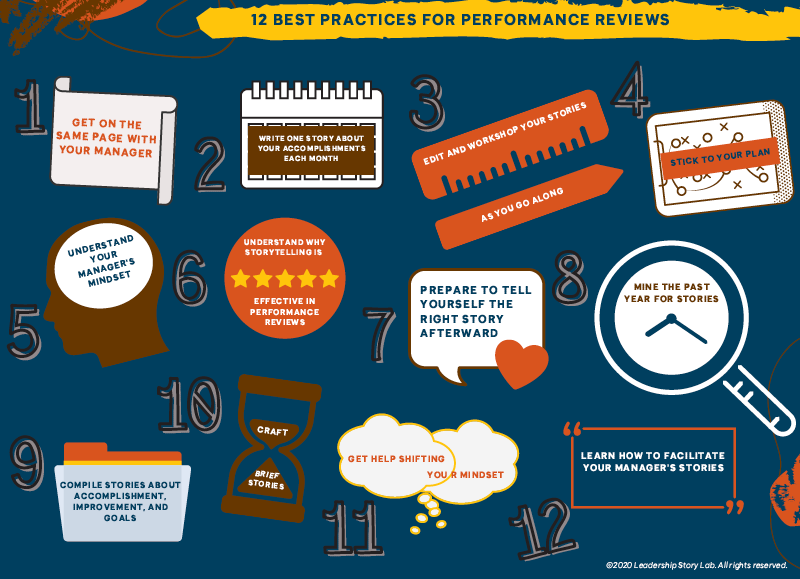November 1, 2020 / Esther Choy

Use storytelling techniques to follow these best practices for performance reviews.
Performance reviews can be nerve-wracking for everyone involved. Massive career decisions hinge on the results.
When we are the ones being evaluated, can we make the process less anxiety-inducing? More importantly, are there ways we can make sure our accomplishments get the notice they deserve?
Fortunately, the answer to both questions is a resounding “yes”– if we take the time to apply storytelling techniques. Here are the best practices for performance reviews, using leadership storytelling to excel and connect.

We’ve broken these twelve tips into four chapters so you can feel free to navigate to the tips that are most relevant to you!
- Chapter One: Plan ahead
- Chapter Two: Shape your internal narrative
- Chapter Three: Craft your stories
- Chapter Four: Get coaching
Chapter One: Plan Ahead
Picture yourself in November or December. End-of-year deadlines are looming. They’re going to be hard to meet. Many projects are behind schedule… not to mention over budget.
To complicate things, you have family staying with you over the holidays.
Oh, and your family is planning to hop on a plane for a trip too.
On top of that, you have to prepare to evaluate your team even while you’re preparing for your own performance evaluation.
Oh wait… what happened during the year? You have an eerie feeling that lots has happened but…what was it again? Surely there’re important things you’re forgetting!
By the time many of us are scrambling to distill a year’s worth of hard work into a brief narrative that will make us shine during our performance evaluation, hundreds of memories have already been lost.
The good news?
It doesn’t have to be this way. One of the best practices for performance reviews is to set aside time as early in the year as you can (January, if possible!) to start planning for your performance review. Here’s how.
1. Get on the same page with your manager.
Send your boss these three questions. Ask them to sit down or hop on Zoom with you to discuss them.
- If you could accomplish three major things for our immediate team this year, what might those be?
- What are the most urgent changes you’d like to see our entire organization embark on?
- How can I help?
Chances are you’ve already established your objectives and action items for the year, especially if your organization follows a standard performance evaluation template.
This conversation will help you connect those to the big picture of what your manager wants the organization to accomplish.
2. Write one story about your accomplishments each month.
Once a month, write your “If You’re Only Remembered As” Story. (IYORS) Here’s how it works.
- At the end of each month, ask yourself this question: “If the only thing my boss can remember about my performance this month is this story, and this story alone, what would it be?”
- Take three minutes to go through your calendar day by day in the past month to jog your memories of various significant moments at work.
- Then, give yourself the following writing prompt: “Upper level management might have a shrinking memory, but they have a little bit of space for me. What is one short story they could remember about my performance?”
- Start writing. Don’t over think.
Save your story. Back it up. Repeat once a month, preferably at the end of the month. During your annual performance evaluations, your future-self will thank your present-self profusely!
3. Edit and workshop your stories as you go along.
Once you’ve put pen to paper and captured stories that would otherwise be lost, you’ve done the hard work. You’ve fought the blank page and won!
Now you can start editing and getting feedback. Start this as soon as you have one or two stories in your collection.
Edit: Condense the story to 500 words or fewer. If you’re over with the word limit, you’ve probably included unnecessary details. Not sure what to cut? Here are 7 Tips for Clear and Concise Writing from MasterClass.
Seek feedback: Share your draft with trusted colleagues, friends or partners who know your work intimately.
- Ask if they are moved or impressed by the story. Did you undersell or overblow your contribution?
- If they were your managers and read the story, what would they make of who you are?
4. Stick to your plan.
Now you have a plan. Hurrah! But we all know what can happen to the best-laid plans. (I’m especially aware of this as I write at the end of 2020, the strangest year many of us remember.)
How can you make sure nothing gets in the way of actually sitting in the chair and writing?
Here are three ideas:
Block out time.
For example, write every Sunday afternoon at 4 pm. Chances are, if it’s in your calendar, it will happen.
Get a buddy to write with you.
Much like having a workout partner, you will more likely keep going back to the gym, or to the writing desk, if you have someone to keep you accountable.
Set a calendar notification.
Set it for the same time and date every month, reminding you to write. Populate it with prompts, such as:
-
- Which goals have you accomplished in part or in full?
- What did it take to get this done?
- Who helped?
- What strengths of character did you demonstrate as you worked on this?
Feel free to reach out to us if you need writing prompts. We can customize some for you!
Are you somebody who has trouble prioritizing writing? It really can be difficult among all the tasks and pressures that pile up for leaders.
I definitely found that to be the case when I was writing my book, Let the Story Do the Work.
Here’s how I got it done. Check it out if you need in-depth input on how to plan ahead for storytelling success.
Setting aside time to reflect on your performance will not only help your accomplishments win notice. It will also change your performance itself. Rather than working in isolation, you’ll find connection to the organization’s mission. And as you reflect monthly on how you want to be remembered, you will infuse your work with a sense of the kind of legacy you want to leave and the kind of person you want to be.
Chapter Two: Shape Your Internal Narrative
Representing your accomplishments well is not just a matter of telling your manager good stories. It also requires telling yourself the right stories. That’s why shaping your own internal narrative is one of the best practices for performance reviews.
5. Understand your manager’s mindset.
That manager you are nervous to meet with is likely dreading the meeting more than you are. Reviewing others is not something most bosses look forward to.
Can you make it easy, if not enjoyable, for them? Is this a pie in the sky idea?
Not if you deploy this one leadership storytelling technique: strategically shifting your point of view.
Shift your point of view, and you’ll notice the many biases that can plague managers. After all, reviewing a year’s worth of performance means battling a host of natural but detrimental tendencies, including:
- Recency bias: evaluating only the past month or two, rather than the full year.
- Leniency bias: giving everyone high marks, regardless of whether it’s merited.
- Confirmation bias: seeking only information that confirms the manager’s preconceived ideas about that person.
Awareness of common biases allows you to look through the glasses your manager could be looking through.
6. Understand why storytelling is effective in performance evaluations.
Once you understand the common biases your manager faces, you can use storytelling techniques to chip away at these so they notice your strengths.
The truth is, facts are easily forgotten. But storytelling has the power to make your performance stand out. Facts are up to twenty times more memorable when part of a narrative.
Telling a story can influence the details your manager remembers.
After all, you want your manager not only to have a good impression of your performance, but also to be able to repeat key points to anyone who has a say in whether or not you get recognized for your contributions.

7. Prepare to tell yourself the right story afterward.
What if you get bad news or difficult feedback? After performance appraisals, over half of 1,500 U.S. workers surveyed said they were surprised by the results. Twenty-two percent cried, 37% looked for another job, and 20% flat-out quit, according to a study by Adobe.
As Wharton professor Adam Grant notes, performance reviews can reveal our blind spots, “but we don’t want to admit we’re blind.”
When a manager’s feedback comes as a surprise, make sure you are telling yourself the right story about the bad news. Again, try to shift your perspective to your manager’s point of view. How were they trying to help you, and the company, grow?
Verbalize that story, and try running it past someone you trust. Do they agree with your perspective? Can they add to what your manager might be thinking?
Chapter Three: Craft Your Story
Finding the right stories and structuring them effectively are both among the best practices for performance reviews.
8. Mine the past year for stories.
Take stock of your past year, digging deep into the caverns of your memory for stories. As you unearth stories, inspect them as if you are your manager. Doing your job and even doing it well is not worth noting.
Use these questions to consider what you might have done that your manager didn’t expect:
- What are my biggest contributions to the company or team this year?
- How are these contributions above and beyond my call of duty?
- What is it about these contributions that makes them so unexpected that my manager will want to reward me?
- Have I learned new leadership skills or industry insights this year?
- Did I share them with my team? If so, what difference has it made to them?
9. Compile stories about accomplishment, improvement, and goals.
Accomplishments.
If your manager were to repeat one of your accomplishments to others, what would you want it to be? What positive impact have you made this year that few people might have noticed?
Improvement.
Inevitably, the evaluation will identify areas for improvement. Craft a story about what you’re doing to improve.
- What was the biggest investment you made this year (at work, in professional development, etc.)? How did this investment go above and beyond what your manager expected?
- What did you read or listen to this year? How has it made a difference to your colleagues? What does it tell you about how you want to grow?
Goals.
Use stories to convey your dreams, choosing stories from two categories:
- Those most logically tied to your organization’s overall goals;
- Those that build on the accomplishments you’ve already achieved.
10. Craft brief stories (3-4 sentences).
Using the “IRS model,” you can craft a story with only three or four sentences:
- I – Intriguing beginning (first sentence or two)
- R – Riveting middle (next sentence or two)
- S – Satisfying end (final sentence or two)
Here’s an example that takes the manager on a journey with the employee:
“Our company has traditionally relied on individual customers, but this year we diversified our revenue by approaching corporate clients. I led the effort to serve our first corporate client. The pilot was not only successful, as the client has agreed to renew the contract, it also served as a roadmap as we scale our services to corporate clients. The company asked me to continue leading the initiative.”
Here’s how it works:
- Intriguing beginning: It positions the company as trying something new. The audience perks up, wanting to know how this worked out.
- Riveting middle: It takes the listener on the journey, showing this employee’s new responsibilities.
- Satisfying ending: It describes how well everything worked out for the company and the employee.
Chapter Four: Get Coaching
At work, most of us tend to be too busy “doing,” which gets in the way of thinking and reflecting. Coaching gives you permission to find mental space and fully take time to take stock, and that’s why it’s one of the best practices for performance reviews.
11. Get help shifting your mindset.
As much as you try to shift into your manager’s mindset, it’s easy to overlook actions and attributes that seem obvious or unimportant to you but would be significant to your manager. We’re not used to shifting to others’ perspectives. It’s hard work. And it’s a storytelling muscle that leadership storytelling coaching can help develop.
But that’s not all.
When you take the time to reflect along with a coach who can draw out your stories, you’ll gain new ideas and techniques about how to tell yourself stories you should have been telling yourself and others all along.
12. Learn how to facilitate your managers’ stories.
Coaching can also help you find the right questions to ask your managers to draw out their stories. Leadership Story Lab has developed ten Crazy Good Questions that can help you deepen your workplace connections, including your connection with those a few rungs above you. (Download the questions here.)
For instance, the first Crazy Good Question is about origin. This isn’t something employees often think to ask about–or, they may think they already know the answer. However, you might be surprised by your manager’s answers to questions like, “What motivated you to choose this career or this company?” or “How did your career begin?”
Comparisons and contrasts are also key. For instance, you and your manager could learn important information if you were to ask: “How did this year compare to last year?”
The bottom line is this: the more you can help your manager reflect, the more valuable you become to them. If this is a skill you’re interested in developing, by the way, we’d love to support you. We offer Storytelling Facilitator certification.
Looking for stories encourages deeper reflection. Much like shuffling through photographs to create a scrapbook, it helps us make sense of our year. And shifting from proving our performance to reflecting on what matters to us can defuse our anxiety.
Related Articles
3 Basic Storylines You Should Be Using In Business Contexts
Create A Story Library in 1 Minute a Day
Better Every Story
Leadership Transformation through Storytelling
"This is an amazing and insightful post! I hadn’t thought of that so you broadened my perspective. I always appreciate your insight!" - Dan B.
Get Esther Choy’s insights, best practices and examples of great storytelling to your inbox each month.




